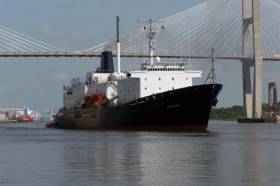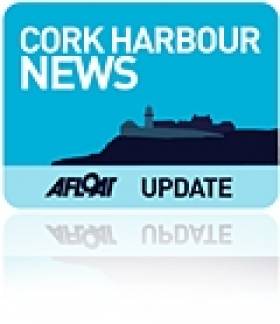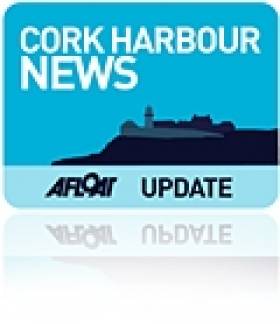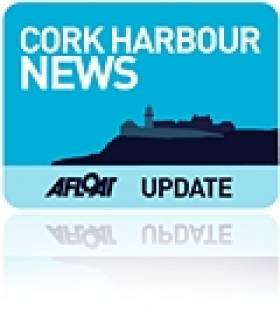Displaying items by tag: Cork Harbour News
Quay Cork Developments Set to Transform City and Harbour
#MajorDevelopments - Major developments worth several hundred million euro are signalled for strategic Cork city and harbour water-fronting sites, at CIÉ-owned Horgan’s Quay, and separately at Marino Point for Port of Cork.
The Irish Examiner writes that a powerful development partnership of investment and development company Clarendon Properties, jointly with builders BAM Ireland has been selected by tender by CIÉ, for a sizeable six-acre site at Horgan’s Quay/Kent station, used by two million rail passengers a year.
The prime site at the city/western end of the sprawling Horgan’s Quay plot at Railway Street, is expected to be developed for offices for FDI companies/financial services, plus apartments for the rental market, along with leisure, most likely a hotel/aparthotel, plus shops and services.
Likely to have a feature building at the city end, where CIÉ is currently developing a new access point to Kent Station and including some protected structures, it has scope to be the oft-heralded game-changer for Cork city’s quays and docklands development, recovering pace after the economic crash and construction sector collapse post-2008.
For more including plans for the former IFI plant and jetty at Marino Point in the centre of the harbour, click here
US Maritime Trainee Schoolship Bids Cobh Farewell
#UStrainingShip - In this 75th anniversary of the Maine Maritime Academy, their flagship trainee schoolship which has been on a visit to Cobh, departed Cork Harbour this morning, writes Jehan Ashmore.
TS State of Maine is one MMA’s fleet of 60 vessels and the 52m/500-foot converted oceanographic research vessel built for the US Navy. Acquired in 1997, the vessel is the college flagship of the Marine Transportation program. The training ship's homeport is Castine Harbour in Maine.
The academy was founded in 1941 and enrolls more than 900 students from 35 states and from several foreign countries. Students in the college are awarded A.S., B.S., and M.S. degrees in 15 fields of study. The schoolship provides an opportunity for midshipmen to get hands on experience afloat.
Commissioned for the US Navy as the USNS Tanner, the vessel was built by Bethlehem Steel Corporation at its Sparrows Point Yard in Maryland in 1990. For the next three years she served in the US Military Sealift Command.
The Irish Continental Group (ICG) in April acquired fastferry, Westpac Express and as previously reported on Afloat.ie last month the craft was onward delivered to Sealift LLC. They in turn chartered the craft to the US MSC.
During the training ship's visit Cobh, was also berthed at the cruise terminal berth the local tug, Alex. Likewise of the schoolship, the tug of 397 gross tonnage has origins with the North American continent having been built in neighbouring Canada in 1995 and based out of Halifax.
Oil Refinery at Whitegate of ‘Strategic Energy Importance’ to Ireland
#Refinery - The Irish Examiner writes that the Port of Cork is partially “insulated” said its chairman from future developments at Whitegate oil refinery but has a clear preference for it to remain operational.
The refinery’s future continues to hang in the balance as the obligation on its owner Phillips 66 to operate the facility until July 2016 draws closer.
The ongoing uncertainty is cause for concern for the port which counts on Whitegate for 55% of its freight traffic.
The possibility that the refinery would be converted to a storage facility if the “worst-case scenario” came to pass offers some solace regardless of whether Whitegate remains operational, said Port of Cork chairman John Mullins.
To read more from the newspaper's story click here.
City of Cork on the Up In 2016
#TideTurns-The Irish Examiner looks at future developments of the City of Cork, among which are featured below plans for the city-centre ‘docklands’ and for the port downriver in the lower harbour.
The An Bord Pleanala granting of planning for Port of Cork’s move and expansion to Ringaskiddy (and, partly to Marino Point too) will be of major consequence from 2018. This will facilitate agri-business growth and freeing up high-value sites in the city’s quays for offices, hotels and apartments.
It won’t be the over-arching and grandiose Dockland plans of the early 2000s, but development will be facilitated, with some remarkable sites such as Port of Cork’s bonded warehouses and own classic, limestone offices coming up for grabs.
In addition the former Haulbowline Industries site at Passage West, which as previously reported on Afloat went for €25 million less than a decade ago, is now on the market for a fraction of that price.
To read more on all developments, the newspaper reports here.
Challenge to Permission for Scrap Metal Facility at Cobh Dismissed
#RushbrookeScrap - The High Court has dismissed a challenge to An Bord Pleanála’s grant of permission for construction of a scrap metal processing facility at the former ship-building yard in Cobh, Co Cork.
Mr Justice Seamus Noonan rejected the challenge by local residents aimed at overturning the March 2013 permission for a scrap metal processing facility, waste storage facility and quayside storage at Cork Dockyard, Rushbrooke Commercial Park, Cobh.
There was nothing unreasonable or irrational about the board’s decision, he said.
After Cobh Town Council refused to grant permission for the project, that decision was appealed to An Bord Pleanála.
To read much more The Irish Times has a report here.
Causing A Turmoil As Expedition Motor Yacht Calls to Cork City
#ExpeditionYacht - It is refreshing to report on a leisure based visitor to Cork Harbour that is neither a massive sized cruiseship or a stereotypical private motoryacht, as Turmoil has proved today, writes Jehan Ashmore.
The Turmoil, a luxury expedition motoryacht berthed this morning close to Cork City centre along North Custom Quay, having sailed from Cardiff.
At 64m /210 ft the steel hulled motoryacht is just shy in length to that of the decommissioned L.E. Aoife of 65.2m. It should also be noted the ‘Emer’ class OPV is a continuation in design terms of the L.E. Deirdre, which when sold was converted into a luxury private expedition yacht.
As for the ‘Aoife’ she currently remains berthed alongside Cork Dockyard following her refit in dry-dock mostly during August. She is to begin a new career having been donated by the Irish State to the Armed Forces of Malta maritime squadron.
Turmoil, with her stylish superstructure (mostly made of aluminium) stands three decks and is situated well aft, a typical characteristic of such expedition superyachts. Ahead of the wheelhouse at this forward deck is where a boat-derrick is mounted for the motoryachts tender craft.
The general exterior design of the expedition yacht are from Ole Steen Knudsen and Tom Fexas while the interiors are those by the hand of Destry Darr Designs.
She can sleep a total of 12 people where her guests are pampered and catered for by approximately 16 crew. The interiors are based on a country manor with floor to ceiling timber panelling dominating the overall appearance of the luxury yacht.
At the time of her launch in 2006 at Royal Denship AS in Aarhus, she was the Danish yard’s largest expedition yacht. Likewise of the ‘Aoife’ she underwent a refit, albeit only two years after completion, where the motoryacht had maintenance and alteration work carried out to continue her self-sufficient worldwide-expedition role.
In order to cover long distances, Turmoil has twin-ample Caterpillar main engine that delivers a maximum of 16 knots, though for cruising this is reduced to 14 knots for a range of 6,500.
The engine generates 2260 horse power (or 1686 kilowatts). Her total HP is 4520 HP and total Kilowatts are 3372. She is driven by twin screw propellers.
#USschoolship – US students from a schoolship berthed in Cobh have been training at the National Maritime College of Ireland, writes Jehan Ashmore.
The 12,524 tonnes schoolship State of Maine as previously reported on Afloat.ie is operated by the Maine Maritime Academy.
240 students had completed exercises in recent days in the college located in Ringaskiddy that faces Cobh.
Among the exercises that took place in the facilities pool, the Damage Repair Unit and the jetty which features a free-fall lifeboat.
State of Maine originally served as USN supply-ship built in 1990 and during her port of call she berthed along Cobh's deepwater cruise-berth quay.
This morning the 143m vessel departed Cork Harbour and is understood to be heading to the for Norfolk, Virginia.
US Trainee Schoolship State of Maine Makes Cobh Call
#USschoolship - Cobh which is synonymous with cruiseships is host to a US training schoolship with up to 300 students on board, writes Jehan Ashmore.
The 12,524 tonnes schoolship State of Maine is understood to have departed her homeport of Portland Me on 13 June. She is berthed at the Cobh's Deepwater Quay during an annual Summer Training Cruise for the Maine Maritime Academy.
State of Maine, is the flagship of the Academy and offer trainees a Vessel Operations and Technology (VOT) program that leads to a Bachelor of Science degree. The VOS curriculum is designed to prepare students for positions of responsibility as operators and managers of a variety of private and commercial vessels.
If qualified, students may sit for the U.S. Coast Guard examination for 500-ton or 1600-ton Near-Coastal Mate's License. Those who complete the curriculum can have careers aboard tugs and barges, ferries, passenger vessels, tall ships, and mega-yachts.
Prior to her current role, the 142m State of Maine had begun a career as the US Navy supply ship USS Tanner when launched by the Bethlehem Key Highway yard in Baltimore.
The blue hulled vessel presents a distinctive profile given two large white angular superstructure blocks to accommodate quarters for her trainees.
For those wondering what is the next cruiseship due to berth at Cobh, this will be Azamara Journey on 6 July. The 30,000 tonnes cruiseship with up to 686 passengers is operated by Azamara Cruises.
Also scheduled to visit Cork Harbour that same day is Magellen, as previously reported the new flagship of Cruise & Maritime Voyages which is due to Ringaskiddy.
#Lusitania100 - A commemoration ceremony hosted by Cunard and the Port of Cork was led by President Michael D Higgins today in Cobh to mark the centenary of the sinking of the Lusitania off the Cork coast.
Shortly after 7am, Cunard liner 'Queen Victoria' arrived at Cobh cruise terminal with 2,144 passengers on board a seven night 'Lusitania Remembered' voyage which included a wreath laying ceremony held off the wreck site in the early hours of this morning.
The commemorations ashore commenced with the unveiling of four glass headstones, commissioned for the centenary by the Port of Cork and Cunard, at the Old Church Graveyard where the bodies of 170 victims of the Lusitania are buried in what were previously unmarked graves.
President Higgins arrived to a full ceremonial welcome shortly after 1pm and proceeded to the town promenade where thousands had gathered.
The whistle of 'Queen Victoria' at 2.10pm marked the moment that the Lusitania was hit by a torpedo 100 years ago. Just 18 minutes later, a second whistle at 2.28pm marked the moment that RMS Lusitania sank with the loss of 1,198 lives.
Many relatives of those who died were in Cobh to remember their loved ones and to pay tribute to the efforts shown by the people of Cobh (then known as Queenstown) in the aftermath of the tragedy.
Speaking about the centenary commemorations, Captain Michael McCarthy, Port of Cork said "The Port of Cork has enjoyed a long relationship with Cunard and all three Cunard Queens have visited Cork harbour in recent years. The Lusitania has particular resonance with Cork and Cobh in that so many of those who lost their lives are buried here. In fact for the last number of years the Port of Cork and Cunard have held a memorial service at the Lusitania monument when a Cunard liner called to Cobh."
He continued "The sinking of the Lusitania was a human catastrophe on a scale that the small town of Cobh (then known as Queenstown) had not experienced before or since and the commemoration is a very fitting tribute to all those who lost their lives on the 7th May 100 years ago. It also serves as an opportunity for us to pay tribute to the people of Cobh, a community which mobilised itself and helped survivors and the dead with such courage and compassion in the aftermath of this tragedy, and to whom we will be forever grateful for their heroic response. "


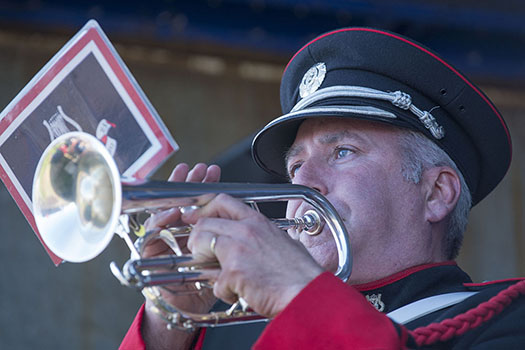
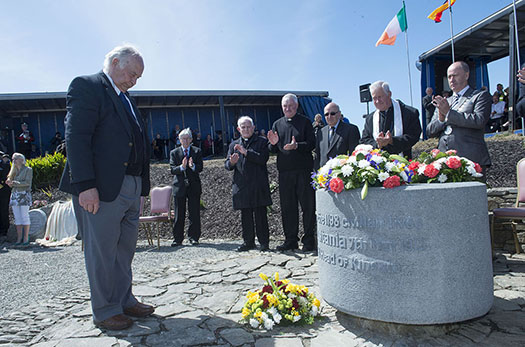
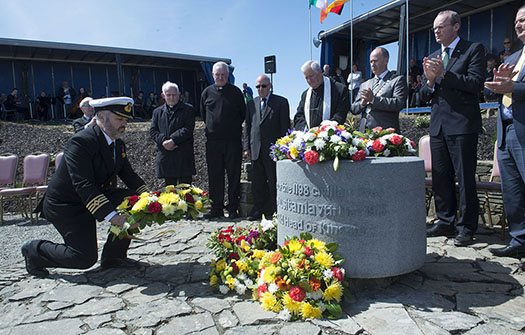
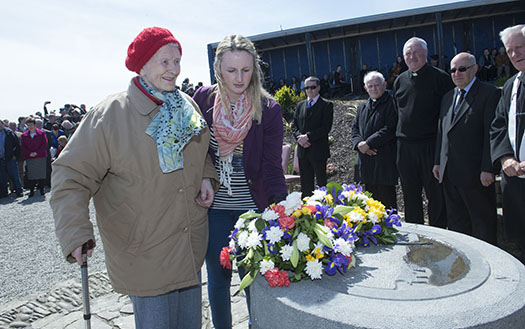
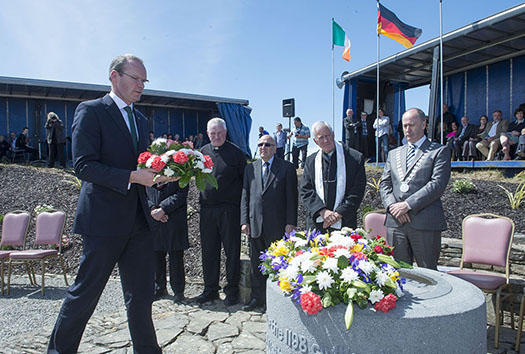
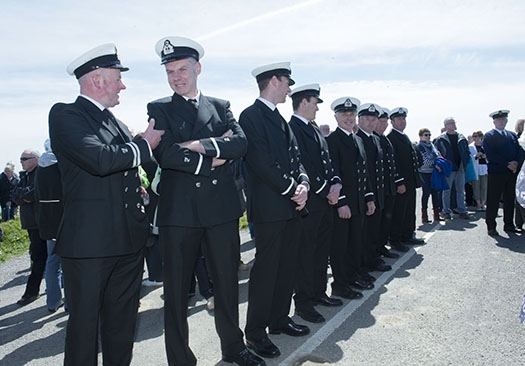
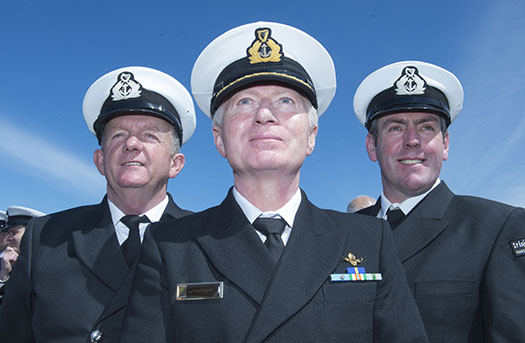
Photos by Gerard McCarthy
Lusitania is still a grave site for hundreds of people that went down with the ship. Let's not forget that these were people and families with hopes and dreams just like ourselves.
What we do know is that on May 7th 1915 the rules of war were deliberately changed in that there were no civilians any more, only targets, and the only thing that would change across every subsequent war was the size and number casualties. It also heralded an era of new and sophisticated weapons of mass destruction and the tactics for their deployment. Many believe the age of 'total war' began off the south coast of Ireland on this day 100 years ago.
Today the Lusitania jealously guards her secrets and soon they will rust into oblivion beyond histories ability to retrieve them.
David Dingle, Chairman of Carnival UK, the owners of Cunard said "Today we remember not only the loss of the Cunard flagship Lusitania and 1,195 lives on 7 May 1915 but also the loss of 20 ships Cunard lost in the First World War.
As well as time to remember it is also an occasion to feel pride in the role Cunarders played when answering the call of their country during that war. And today's commemoration has allowed us to feel both emotions. We will remember them!"
Following the commemoration service in the town promenade, President Higgins laid a wreath at the Lusitania monument along with Commodore Rynd, Master of Queen Victoria; Kevin O'Malley, US Ambassador; Dominick Chilcott, British Ambassador and Wolfram von Heynitz, Chargé d'Affaires German Embassy.
Commemorations continued with a concert by Ryan Morgan, Amanda Neri and Joe Corbett accompanied by the Brandy Lane Orchestra in the town promenade.
#ResearchNavy - A Russian research vessel built during the Soviet era along with the Naval Service's newest patrol vessel LÉ Samuel Beckett (P61) are at Cork Dockyard, writes Jehan Ashmore.
Geolog Dmitriy Nalivkin of 1,935 tonnes was built in Turku, Finland during 1985. She originally had the Soviet symbolism of the 'hammer & sickle' and star on the funnel.
Three decades later and her current owners are understood to be the Marine Arctic Geological Expedition Murmansk (MAGE).
The 71m vessel is berthed alongside the quay at the facility in Rushbrooke so to have an exchange of crew personnel.
Among the other vessels at the shiprepair facility is the general cargoship Arklow Rambler also taking a riverside berth.
As previously alluded the LÉ Samuel Beckett, the 2,256 tonnes OPV is undergoing her first scheduled annual maintenance with work carried out in the dry-dock.
The OPV90 or 'Beckett' class vessel was built last year from the UK yard of Babcock Marine & Technology in Appledore north Devon.
She was commissioned in May and entered service also that month.




























